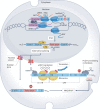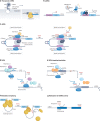Amplifying gene expression with RNA-targeted therapeutics
- PMID: 37253858
- PMCID: PMC10227815
- DOI: 10.1038/s41573-023-00704-7
Amplifying gene expression with RNA-targeted therapeutics
Abstract
Many diseases are caused by insufficient expression of mutated genes and would benefit from increased expression of the corresponding protein. However, in drug development, it has been historically easier to develop drugs with inhibitory or antagonistic effects. Protein replacement and gene therapy can achieve the goal of increased protein expression but have limitations. Recent discoveries of the extensive regulatory networks formed by non-coding RNAs offer alternative targets and strategies to amplify the production of a specific protein. In addition to RNA-targeting small molecules, new nucleic acid-based therapeutic modalities that allow highly specific modulation of RNA-based regulatory networks are being developed. Such approaches can directly target the stability of mRNAs or modulate non-coding RNA-mediated regulation of transcription and translation. This Review highlights emerging RNA-targeted therapeutics for gene activation, focusing on opportunities and challenges for translation to the clinic.
© 2023. Springer Nature Limited.
Conflict of interest statement
C.W. is a co-founder of Epigenetix and Jupiter Neurosciences, Inc., and serves on scientific advisory boards of Camp4 Therapeutics, Cascade Biotechnology, Galatea Bio and Ribocure. O.K. is employed by OPKO Health.
Figures




References
Publication types
MeSH terms
Substances
Grants and funding
LinkOut - more resources
Full Text Sources

